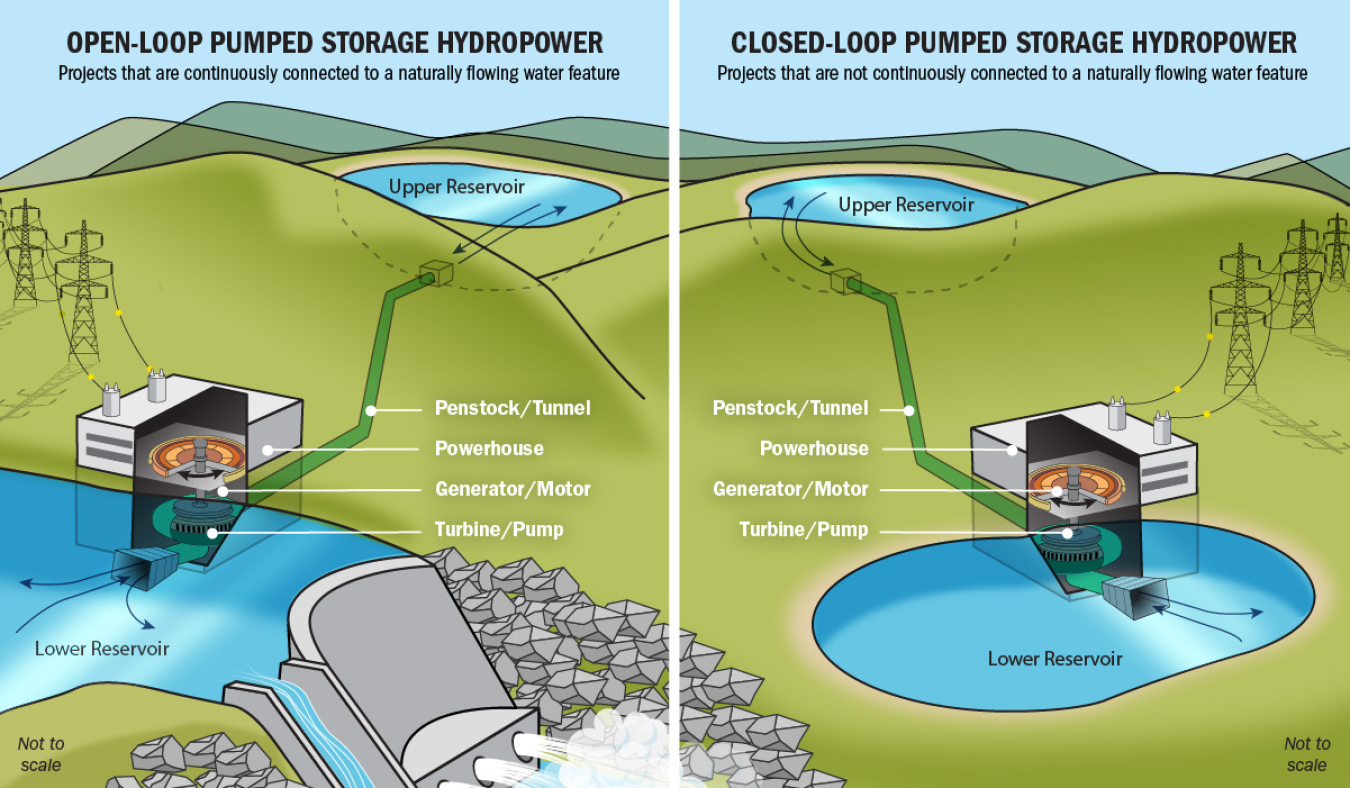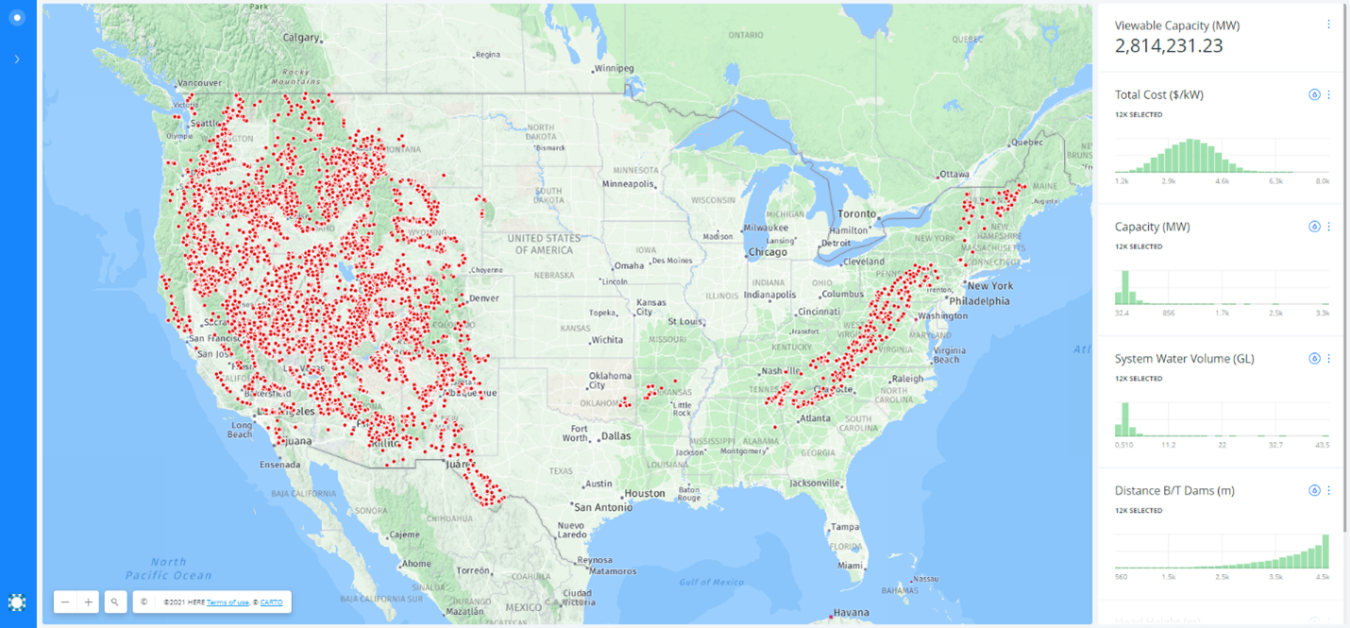Although PSH has been around for over 100 years, two new studies from the Water Power Technologies Office under its HydroWIRES Initiative demonstrate that much of its potential remains untapped.
Water Power Technologies Office
June 13, 2022The U.S. electric grid is evolving rapidly, creating new opportunities and challenges for renewable energy deployment. While advances in wind and solar technologies are enabling the growth of low-cost, clean energy across the U.S., they have also increased the need for long-duration energy storage to balance their variability.
Currently, about 93% of all grid-scale energy storage capacity in the U.S. is provided by pumped storage hydropower (PSH). PSH facilities run water back and forth between two reservoirs at different elevations, allowing them to both generate energy and store energy for later use. PSH is a flexible, renewable, and commercially available technology for energy storage.
Although PSH has been around for over 100 years and already accounts for most grid-scale energy storage, two new studies from the U.S. Department of Energy’s (DOE) Water Power Technologies Office (WPTO) under its HydroWIRES Initiative demonstrate that much of its potential remains untapped.
Study Identifies Promising Innovations that Can Reduce Costs and Speed Deployment of Pumped Storage Hydropower
The first study, conducted by Argonne National Laboratory, looked closely at many promising new PSH technologies, and highlights three in particular that have the potential to significantly reduce cost, time, and risk for new PSH projects:
- Submersible Pump-Turbines and Motor-Generators Could Reduce Infrastructure Build Out Needed for PSH
Conventional PSH plants use reversible pump-turbines that are submerged below water and non-submerged motor-generators above them in a powerhouse. This innovative energy storage concept submerges both devices, thus eliminating the need to construct the powerhouse altogether. This technology has the potential to reduce costs and construction time. Because of the smaller footprint and lessened construction, this technology may also be applicable at existing hydropower plants and for adding generation at non-powered dams.
- Geomechanical PSH Could Greatly Expand Locations where PSH can be Placed
This concept involves pumping water between specific rock layers, where water would be kept under pressure until a valve is opened, releasing it into a hydroelectric turbine. Unlike conventional PSH, this technology does not require hilly terrain to provide an elevation difference between reservoirs; it can be located anywhere with the right geological rock formations. This means this form of geomechanical PSH technology could be implemented in many sites across the United States unsuitable for conventional PSH, while also offering the benefit of lower project costs, faster construction, minimal environmental impacts, scalability, and longer lifetime.
- Open Pit Mine PSH Can Reduce Need to Build New Storage Reservoirs
This technology proposes to use decommissioned open pit mines to develop PSH reservoirs, which would help new projects save costs and time versus conventional PSH projects that need to construct reservoirs. Open pit mine PSH could also lower environmental impacts and help utilize and rehabilitate existing brownfield sites.
The report also talks about projects that pair PSH with variable renewable energy generation (such as wind or solar) aka ‘hybrid PSH’, and those converting existing, suitable hydropower projects to PSH, as additional opportunities to expand PSH and support a reliable, flexible grid.
Study Finds Thousands of Locations Across the U.S. Suitable for Closed-Loop Pumped Storage Hydropower
All of the country’s currently operating PSH projects are considered open-loop, which involves connection to a natural water source for water input. In contrast, closed-loop PSH is located “offstream,” meaning it isn’t continuously connected to a natural water source, and will generally have less environmental impact than open-loop.

Comparison of Open-Loop and Closed-Looped PSH. Image Courtesy of PNNL.
As the need for more energy storage grows, so does interest in closed-loop PSH, including the filing of several preliminary permit and licensing applications. A second study, this one by the National Renewable Energy Laboratory (NREL), looked at this technology and its potential in specific regions across the United States.
This recently completed Closed-Loop Pumped Storage Hydropower Resource Assessment for the United States is a large-scale study of potential closed-loop PSH sites and an important reference for developers and stakeholders. The study used spatial mapping at 30-meter resolution and identified nearly 15,000 sites where this PSH technology can be best deployed in the future.
Researchers expanded on work by Australian National University by using GIS tools to locate suitable topographic features for potential upper and lower reservoir pairs. They also assessed relevant attributes such as reservoir volume, dam height, elevation, and water flow direction. Locations either deemed incompatible with development or that contained a set of paired reservoirs intersecting another reservoir were then filtered out and a cost optimization algorithm was applied to the remaining sites.

In the contiguous United States, the assessment determined over 6.5 million potential lower reservoirs and over 2.1 million potential upper reservoirs before filtering out incompatible locations such as rivers, national parks, or urban areas. This resulted in over 590,000 potential lower reservoirs and over 174,000 upper reservoirs. Once paired and optimized for cost, the model returned 11,769 sites in the contiguous United States, as well as an additional 3,077 sites in Alaska, Hawaii, and Puerto Rico, where closed-loop PSH technology can be best deployed in the future.
Stay in the know with WPTO! Subscribe to the monthly Hydro Headlines and bimonthly Water Wire newsletters for information on hydropower funding opportunities, events, products, and news.

